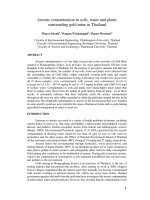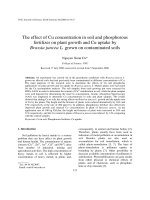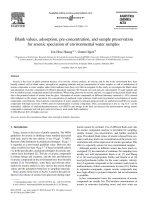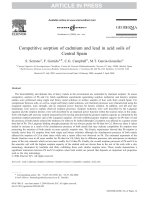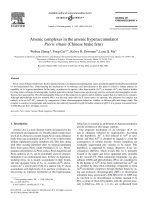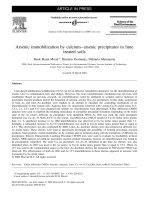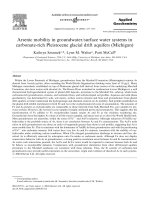Arsenic speciation in contaminated soils
Bạn đang xem bản rút gọn của tài liệu. Xem và tải ngay bản đầy đủ của tài liệu tại đây (164.1 KB, 13 trang )
Talanta 58 (2002) 97–109
Arsenic speciation in contaminated soils
S. Garcia-Manyes
a,b
, G. Jime´nez
a
, A. Padro´
c
, Roser Rubio
a,
*, G. Rauret
a
a
Departament de Quı´mica Analı´tica, Uni6ersitat de Barcelona, A6da. Diagonal,
647
, E-
08028
Barcelona, Spain
b
Departament de Quı´mica Fı´sica, Uni6ersitat de Barcelona, A6da. Diagonal,
647
, E-
08028
Barcelona, Spain
c
Ser6eis Cientı´fico Te`cnics, Uni6ersitat de Barcelona, Lluı´s Sole´ i Sabarı´s,
1
-
3
, E-
08028
Barcelona, Spain
Received 10 December 2001; received in revised form 12 February 2002
Abstract
A method for arsenic speciation in soils is developed, based on extraction with a mixture of 1 mol l
−1
of
phosphoric acid and 0.1 mol l
−1
of ascorbic acid, and further measurement with the coupling liquid chromatography
(LC)–ultraviolet (UV) irradiation–hydride generation (HG)–inductively coupled plasma mass spectrometry (ICP/
MS). The stability of the arsenic species in the extracts is also studied. The speciation method applied to several
Spanish agricultural contaminated soils from the Aznalcollar zone shows that arsenate is the main species in all the
soils analysed and that in some samples arsenite and methylated species could also be detected. The determination of
the ‘‘pseudototal’’ arsenic in these soils, obtained by applying extraction with aqua regia (ISO Standard 11466), is also
carried out. Both the speciation method and the aqua regia method are applied to several certified reference materials
(CRMs) in which total arsenic content is certified. Finally, the same LC– UV–HG coupling with atomic fluorescence
spectrometry (AFS) detection reveals to be a valid coupling system to perform arsenic speciation in the soils according
to its fair quality parameters and easy utilisation. © 2002 Elsevier Science B.V. All rights reserved.
www.elsevier.com/locate/talanta
1. Introduction
Arsenic can occur in agricultural soils in some
regions, as a consequence of the use of arsenic-
containing pesticides and herbicides [1–3]. Other
contributing sources of arsenic in the soils are
industrial and mine wastes. Nevertheless, the con-
tamination of the soils due to irrigation with
groundwater with high arsenic content from natu-
ral origin is widely reported since it affects large
areas in the world [4–8]. In spite of the fact that
arsenic in the soils and also in sediments is mainly
present in inorganic forms, the organic com-
pounds monomethylarsonate (MMA) and
dimethylarsinate (DMA) may be detected [9 –11].
These methylated species can originate from mi-
croorganisms-mediated oxidation–reduction reac-
tions. Moreover, some methylated species can be
demethylated to inorganic arsenic [1,3,12]. The
chemical form of arsenic determines its mobility
from the soils and sediments, As(III) being the
most mobile [13]; thus the knowledge of the chem-
ical forms of arsenic can provide a good tool for
the assessment of their further mobilization to the
aqueous phase in equilibrium with the soils or
sediments.
* Corresponding author. Tel.: + 34-93-402-1283; fax: + 34-
93-402-1233
E-mail address
:
(R. Rubio).
0039-9140/02/$ - see front matter © 2002 Elsevier Science B.V. All rights reserved.
PII: S0039-9140(02)00259-X
S. Garcia-Manyes et al.
/
Talanta
58 (2002) 97 – 109
98
Arsenic speciation has acquired great impor-
tance in recent years, since the toxicity of ar-
senic differs dramatically with the wide range of
its organic and inorganic chemical forms [14–
17]. Nowadays the mechanisms that originate
toxicity are not well elucidated and many efforts
are going on in this subject [18– 21] as well as
on the development of effective therapies [22,23].
The development of analytical techniques that
allow chemical speciation is therefore manda-
tory, since total arsenic determination cannot in
many cases be an appropriate measure for as-
sessing toxicity, environmental impact, or the ef-
fect of occupational exposure [3]. The extraction
of chemical species is a crucial topic in element
speciation studies in complex matrices in which
the extraction system has to provide good recov-
ery and to preserve the identity of the native
species in the sample. Several extracting agents
have been proposed for further measurement of
the arsenic species present in the soils [24–28].
With regard to extraction conditions, mi-
crowaves are revealed as a successful technique
for the extraction of elemental species [29] and is
applied to extract arsenic species in biological
matrices [30–32]. However, few articles [26,33]
deal with the extraction of arsenic species from
the sediments and soils by using low-power mi-
crowaves.
Coupled systems with liquid chromatography
(LC)– hydride generation (HG) and detection by
atomic absorption spectrometry (AAS), atomic
emission spectrometry (AES), atomic fluores-
cence spectrometry (AFS) or inductively coupled
plasma mass spectrometry (ICP/MS) have been
shown to be suitable for measuring arsenic spe-
cies in the extracts obtained from natural sam-
ples even at very low concentration levels. In
such couplings derivatization by generation of
volatile arsines is the common step to reach
good sensitivity.
We present here the feasibility for extracting
arsenic from the soils and sediments by using a
mixture of phosphoric acid and ascorbic acid
under microwaves. The stability with time of the
arsenic species in the soil extracts is also evalu-
ated by using the coupling LC–UV–HG–ICP-
MS for measuring the arsenic species after
extraction. The coupling LC–UV –HG– AFS is
successfully applied and it is revealed as a suit-
able technique for arsenic speciation in the soil
extracts. The quality parameters detection and
quantification limits as well as precision by using
this coupling are established for the soil extracts.
Both couplings are applied in the present study
to the soils collected in the contaminated zone
of Aznalcollar (Spain) [34].
2. Materials and methods
2
.
1
. Apparatus
A Prolabo microwave digester Model A301,
2.45 GHz, equipped with a TX32 programmer
was used. The instrument can apply power set-
tings of 20– 200 W in steps of 10 W, and the
microwave energy was focused into the glass
vessel under atmospheric pressure.
A temperature and time P/Selecta Model RAT
4000051 regulator bloc, which controls the P/Se-
lecta Bloc Digester 12, and which allows 12 ves-
sels to be operated at the same time, was used
in the pseudototal arsenic determination.
A Perkin– Elmer ICP –AES Optima 3200 RL
spectrometer provided with ‘‘cross-flow’’ nebu-
lizator spectrometer was used in the measure-
ment of total arsenic in some soil samples. The
spectrometer is equipped with a 27.12 MHz,
750– 1750 W work power radiofrequency source
and quartz torch. Data acquisition was per-
formed with computer software.
A Karl–Fisher titrator automat 633, pump
unit 681, dosimat 715 and stirrer 728 model, all
of them from Metrohm, Herisaw, Switzerland
have been used as an alternative technique to
determine the moisture of some samples.
Coupled system, LC–UV– HG–ICP/MS, was
used for the determination of the arsenic species.
LC– UV–HG –AFS was also applied and the
quality parameters were established.
The coupled systems include the following
instrumentation.
S. Garcia-Manyes et al.
/
Talanta
58 (2002) 97 – 109
99
2
.
1
.
1
. Separation
A Perkin–Elmer 250LC binary pump (CT,
USA) with a Rheodyne model 7125 injector (CA,
USA) and a 20 ml injection loop was used. An
anion exchange 250×4.1 mm Hamilton PRP X-
100 column with 10 mm spherical poly(styrene–di-
vinylbenzene) containing trimethyl ammonium
groups as exchangers was used, with a guard
column packed with the same stationary phase.
2
.
1
.
2
. UV deri6atization
The photoreactor system combines a Hereaus
TNN 15/32 low-pressure mercury vapour lamp
(u = 254 nm, external diameter 2.5 cm, 17 cm
length, 15 W) and PTFE tubing (12 m length,
internal diameter 0.5 mm) which constituted the
photoreactor system. A computer-controlled mi-
croburette (Microbur 2031 Crison) was used to
add the peroxidisulfate solution into the
photoreactor.
2
.
1
.
3
. Detection systems
(A) A Perkin –Elmer FIAS 400 with a gas–liq-
uid separator equipped with a PTFE mem-
brane was used for HG. A Perkin–Elmer
Elan 6000 ICP-MS instrument was used for
detecting As, and areas were calculated from
custom-developed software using
MATLAB
language. The sample channel was con-
nected to the outlet of the LC– UV system.
The scheme of the overall coupling is re-
ported in [30].
(B) PS. Analytical model excalibur atomic
fluorescence spectrometer equipped with a
As hollow cathode lamp (current intensities:
primary 27.5, boost 35.0) and a Perma pure
drying membrane (Perma Pure Products,
Farmingdale, NJ, USA) for drying the gen-
erated hydride. Measuring wavelength was
193.7 nm. Data acquisition was performed
with a microcomputer by using a home-
made software (
PENDRAGON 1.0
). Peak
heights and peak areas were measured from
custom-developed software running with
MATLAB
language. The scheme of the over-
all coupling is reported in [35].
2
.
2
. Standards and reagents
All the solutions were prepared with doubly
deionized water (USF Purelab Plus, Ransbach,
Baumbach, Germany) of 18.3 MV cm resistivity.
Standard solutions (1000 mg l
−1
[As]) of ar-
senic compounds were prepared as follows. Arsen-
ite
:
As
2
O
3
(Merck, Darmstadt, Germany) primary
standard was dissolved in NaOH (4 g l
−1
). Arse-
nate
:
Na
2
HAsO
4
·7H
2
O (Carlo Erba), monomethy-
larsonate (CH
3
)As(ONa)
2
·6H
2
O (Carlo Erba) and
dimethylarsinate (CH
3
)
2
AsNaO
2
·3H
2
O (Fluka)
were dissolved in water. All the standard solutions
were standardized with respect to arsenic. These
stock solutions were kept at 4 °C in darkness.
More dilute solutions for the analysis were pre-
pared daily.
Extracting reagents
:
Ortho-phosphoric acid
(H
3
PO
4
, Merck Pro analysi, 85% purity) and
EDTA (Merck proanalysi, 99.4 –100.6%). Sodium
dihydrogenphosphate anhydrous (NaH
2
PO
4
,
Merck Suprapur) and L(+ ) ascorbic acid (Merck
proanalysi, 99.7%) were assayed for microwave
extractions.
Mobile phase
:
Phosphate buffer pH 6 was pre-
pared from 100 mmol l
−1
of mixture of NaH
2
PO
4
and Na
2
HPO
4
(Merck, Suprapur). The solution,
after filtering through a 0.22 mm nylon membrane,
was sonicated for 10 min.
Peroxodisulfate solution
:
K
2
S
2
O
8
(Fluka, purity
\ 99.5%) at 5% prepared in sodium hydroxide
(NaOH Suprapur, Merck) at 2.5% was used for
photooxidation step.
Hydride-generating reagents
:
10% sulfuric acid
was prepared from 96% H
2
SO
4
(Merck Supra-
pur). Sodium borohydride (NaBH
4
tablets, Fluka,
purity \ 97%) at 5% in 0.2% NaOH was filtered
through 0.45 mm cellulose membrane and it was
prepared daily.
Nitric acid (HNO
3
, Baker, Instra-analysed,
70%) and hydrochloric acid (HCl, Baker, Instra-
analysed, 36.5–38%) were used for the aqua regia
digestion method.
1% potassium iodide (KI, Merck, Suprapur,
minimum 99.5%) and ascorbic acid (Merck, pro-
analysi 99.7%) 0.2% in HCl 9% were used for
prereduction in the determination of As after
S. Garcia-Manyes et al.
/
Talanta
58 (2002) 97 – 109
100
aqua regia leaching as well as for the determina-
tion of total arsenic in the phosphoric–ascorbic
extracts, when HG–ICP/MS was used.
2
.
3
. Certified reference materials
GBW07405 soil (4129 8mgkg
−1
As) and
GBW07311 sediment (188 9 6mgkg
−1
As) both
were from NRCCRM (PR China), and BCR320
sediment (76.7 9 4.7 mg kg
−1
As) was from BCR
(Brussels, Belgium).
Five soil samples—2AUTr, 2DEPr, 2DEP,
1RIB2 and 2QUEh from the Aznalco´llar zone—
were collected in May 1998. This area was af-
fected in 1998 due to an accident from a mine
waste reservoir. The location of sampling points,
sampling and pretreatment, as well as the charac-
terization of these soils are described elsewhere
[34]. A second sampling in January 2000 was
carried out from this contaminated zone, and five
soil samples were selected for the study—3DEP,
3DEPr, 3RIB, 3QUE and 3QUEorg. 3QUEorg
soil was sampled from the 3QUE soil, but in a
zone in which considerable amounts of manure
was added. Approximately 10 kg of each of these
soils was collected at 5 –8 cm depth and stored in
plastic containers. Samples were dried at 40 °C
during 5 days, then they were gently crushed, and
the particles passing through a 2 mm nylon sieve
were collected and homogenized before analysis.
2
.
4
. Procedure for pseudototal arsenic
determination by using aqua regia leaching
The standard ISO/CD 11466 1995 was followed
for sample extraction. The soil or sediment sub-
sample (3 g of material) was placed in the reflux
vessel and it was wetted by adding 1 ml of water.
Then the appropriate volume of aqua regia (28 ml
per 3 g sample) was added. The cooler was con-
nected and the soil suspension was maintained at
room temperature for 16 h. The water cooler was
connected and the mixture was heated at 130 °C
for 2 h till the extraction was completed. Once at
room temperature, the cooler was washed with 5
mol l
−1
of HNO
3
and the washing solution was
collected into the digestion vessel. The resulting
suspension was filtered through an ashless filter
(approximately 8 mm) and the solid residue was
washed several times with 0.5 mol l
−1
of HNO
3
.
The filtrate together with the washings was di-
luted up to 100 ml with 0.5 mol l
−1
of HNO
3
.
This solution was transferred to a PTFE con-
tainer and stored at 4 °C until analysis. The
arsenic content in the extracts was measured by
ICP– AES or by HG– ICP/MS. When the latter
was used, a prereduction step was carried out. For
this purpose an aliquot of the aqua regia extract
was taken and it was diluted 100-fold. Then 1 ml
of a solution containing KI 1% and ascorbic acid
0.2% in HCl 9% was added to 9 ml of the diluted
solutions, and the mixture was maintained under
room temperature for 1 h before the final mea-
surement. Matrix matching was used for calibra-
tion, and thus all three standards for the external
curve were treated under the prereduction condi-
tions described. In all the cases three independent
replicates were carried out for each sample.
2
.
5
. Procedure for the extraction of the arsenic
species
100 mg of the soil or sediment and 15 ml of the
extractant (1.0 mol l
−1
of phosphoric acid+0.1
mol l
−1
of ascorbic acid) previously purged with
argon stream for 15 min were placed in an open
reflux vessel. The latter was positioned in the
cavity of the microwave digester and the mixture
was maintained at 60 W for 10 min. Once the
solution is at room temperature, a few millilitre of
water was added, and the mixture was filtered and
diluted up to 50.0 ml with water. After filtering
through a 0.22 mm polysulfonic membrane,
aliquots were obtained for the determination of
total arsenic in the extract by using ICP/MS or by
HG– ICP/MS (in this case after aqua regia diges-
tion and the prereduction with KI was carried out
as described before) and for arsenic speciation by
using LC–UV –HG– ICP/MS. When the extract
could not be analysed just after extraction, the
aliquots were kept at 4 °C until analysis.
2
.
6
. Measurement of the arsenic species by using
LC– UV–HG –ICP/MS
20 ml of the extract was injected into the anion-
S. Garcia-Manyes et al.
/
Talanta
58 (2002) 97 – 109
101
exchange column of the LC system. Two phos-
phate buffer solutions at pH 6.0 were pumped at
1mlmin
−1
NaH
2
PO
4
–Na
2
HPO
4
5 mmol l
−1
(solution A) and NaH
2
PO
4
–Na
2
HPO
4
100 mmol
l
−1
(solution B). The gradient programme was
100% A for 2 min, decreasing to 50% A in 0.1 min
and maintained for 3 min, then increasing to
100% A in 0.1 min and maintained for 7 min. The
eluate reached the hydride generator system and
after passing through the gas–liquid separator the
volatile arsines were transferred to the ICP/MS
detector with the optimal argon flow. A detailed
scheme of the coupled system and experimental is
reported elsewhere [30]. The arsenic species were
quantified by the standard addition method in the
extract.
2
.
7
. Measurement of the arsenic species by using
LC– UV–HG –AFS
Detection with AFS coupled to the system was
also used. The separation conditions in this cou-
pling were those described for the coupling with
ICP/MS. The detailed scheme of the coupling and
the experimental detection conditions is reported
in [35]. The arsenic species were quantified by the
standard addition method in the extract.
3. Results and discussion
3
.
1
. Sample pretreatment
A study was carried out to ensure that losses of
arsenic did not take place at 40 °C used for
drying the soil samples. For this, subsamples of
the soils were treated under room temperature
(approximately 20 °C), 40 °C and 100 °C, and
the total arsenic was measured in each case. The
results did not indicate significant differences in
the corresponding arsenic contents.
3
.
2
. Determination of the moisture
All the results in the present study are referred
to dry mass, and the moisture was determined
gravimetrically after a thermal treatment at
105 °C. In spite of the fact that this is the usual
method for determining moisture in the soils and
in order to ascertain whether under this treatment
any volatile compounds present in the soils could
be lost, the Karl–Fisher method was applied to
compare the results obtained with both the meth-
ods. For this purpose, two soils from the second
sampling, 3DEP and 3QUE, were selected, since
they presented different levels of moisture. Ac-
cording to the results the percentages of moisture
for the soil 3DEP were 12.94% (105 °C) and
12.86% (Karl–Fisher), whereas for the soil 3QUE
were 3.12% (105 °C) and 3.03% (Karl–Fisher).
These results showed that only water was lost
during the drying process at 105 °C.
3
.
3
. Determination of pseudototal arsenic content
Arsenic in the aqua regia extracts was measured
by ICP–AES or by HG–ICP/MS, according to
the concentration values for each sample. The
generation of the volatile hydrides increases sensi-
tivity and avoids the significant interference of the
chloride when As is measured directly by ICP/
MS. The pseudototal arsenic content in the soils
2AUTr, 2DEPr, 2DEP, 1RIB2 and 2QUEh is
reported in [34], in these soils the arsenic content
ranged between 12.6 and 766 mg kg
−1
. The re-
sults of pseudototal arsenic in the rest of the soils
studied as well as in the certified reference materi-
als (CRMs) are reported in Table 1. These results
indicated that in some soils, even after 2 years
from the pollution accident, the arsenic content
remained significantly high. For CRMs and in
spite of the fact that aqua regia does not extract
the total metal content, the obtained results are
very close to those reported as certified values,
except for BCR320. A lower recovery against the
certified value is also reported in the literature for
this material [26]. The certified arsenic content in
these materials ranges between 76.7 and 412 mg
kg
−1
. This range can be considered wide enough
to assess the applicability of the aqua regia
method, and this leaching procedure is then a
good approach for the evaluation of the arsenic
content in the soils and sediments by means of an
acidic-oxidative attack that avoids the use of hy-
drofluoric acid.
S. Garcia-Manyes et al.
/
Talanta
58 (2002) 97 – 109
102
3
.
4
. Extraction of the arsenic species from soils
Several extractants were assayed for further
determination of arsenic species in order to assess
the extraction yields of arsenic. NaH
2
PO
4
0.5 mol
l
−1
,H
3
PO
4
0.6 mol l
−1
and EDTA 0.5 mol l
−1
at
pH 7 were assayed independently as extracting
agents on the CRMs GBW07405, GBW07311 and
BCR320, and the extractions were performed un-
der 40 W microwave power. In all cases the
arsenic content in the extract was measured by
using HG –ICP/MS. The values obtained were
compared to those certified in order to calculate
the percentage of the extraction yield of arsenic.
From the results it could be observed that the
extraction recoveries varied according to the type
of the material. The lowest recovery was obtained
by using 0.5 mol l
−1
of EDTA being 3% for
GBW07405, 20% for GBW07311 and 35% for
BCR320. The recoveries obtained by using 0.5
mol l
−1
of NaH
2
PO
4
were 16% for GBW07405,
18% for GBW07311 and 50% for BCR320,
whereas the higher recoveries were obtained by
using 0.6 mol l
−1
of H
3
PO
4
, 50% for GBW07405,
70% for GBW07311 and 80% for BCR320. From
these results phosphoric acid was chosen for fur-
ther extraction of the arsenic species. Once the
extracting agent was selected, the operational con-
ditions were established, since the extraction sys-
tem has to guarantee the inalterability of the
species during the process as well as to provide
reproducible results. Thus we optimized the phos-
phoric acid concentration, the MW power and the
extraction time.
Three phosphoric acid concentrations 0.3, 0.6
and 1.0 mol l
−1
were assayed as extractants. The
extraction time was 10 min, and the microwave
powers assayed were 20 and 60 W. The arsenic
content in the extracts was analysed by HG–ICP/
MS. From these assays 1.0 mol l
−1
of phosphoric
acid, 60 W and 10 min were the conditions ini-
tially adopted. This phosphoric concentration
agreed with that reported in [26]. In order to
prevent any As(III) oxidation that could be
caused by the main soil components in the ex-
tract, the addition of a reducing agent to the
extractant solution was considered. For this pur-
pose a few preliminary experiments were carried
out. In these experiments four reducing agents
were assayed—sodium bromide, oxalic acid, hy-
droxyl ammonium chloride and ascorbic acid at
several concentrations, and each of them mixed
with phosphoric acid was assayed. As(III) in the
extracts were analysed by LC– UV–HG– ICP/
MS. From these assays ascorbic acid was revealed
as the best preservative for arsenite. The recovery
of As(III) without the addition of ascorbic acid
reached 93.7%, whereas when ascorbic acid was
added the As(III) recovery increased up to 98.9%
and no peak of As(V) was observed in the corre-
sponding chromatogram. Thus a solution contain-
ing 1.0 mol l
−1
of phosphoric acid and 0.1 mol
l
−1
of ascorbic acid and 60 W microwave power
during 10 min were the conditions adopted for
extraction.
3
.
5
. Quality parameters
LC– UV–HG –AFS
:
The detection limit (DL)
was calculated from the background signal in the
Table 1
Arsenic content in the contaminated soils and in CRMs, after
the aqua regia leaching, expressed as mg kg
−1
Material Arsenic content (mg kg
−1
) Certified value
3RIB 173
a
15
b
19.9
c
3DEP
1.3
b
3DEPr 15.4
c
1.64
b
712
a
3QUEorg
1.9
b
769
a
3QUE
55
b
412412
a
GBW07405
8
b
11
b
188GBW07311 180.7
a
13.6
b
6
b
BCR320 76.767.3
c
3.4
b
3.2
b
a
Measurement by ICP–AES.
b
Standard deviation (n=3).
c
Measurement by HG–ICP/MS.
S. Garcia-Manyes et al.
/
Talanta
58 (2002) 97 – 109
103
Table 2
As species in the CRMs GBW07405, GBW07311 and BCR320, after applying the extraction procedure proposed and measurement
with LC–UV–HG–ICP/MS
DMA MMA As(V) U1As(III) U2CRM As
extr
(As
extr
/As
cert
)%
n.d. 1.0GBW07405 275.12.5 n.o. 18
a
336.6 81.7
0.2
b
49.5
b
0.4
b
4.8
b
GBW07311 2.9 n.d. n.d. 157.4 2
a
n.o. 190.8 101
0.5
b
23.7
b
6.7
b
n.d. n.d. 35.6BCR320 1
a
7.9 1
a
73.5 95.8
1.5
b
7.1
b
1.8
b
n.d., below the detection unit; n.o., non-observed; As
extr
, total As measured in the extract; As
cert
, As certified. The recovery values
calculated as the As extracted against the certified As content (see Table 1), respectively, are also reported (n=3).
a
Estimated value (see text).
b
Standard deviation (n=3).
Fig. 1. Chromatogram corresponding to the BCR320 sediment (measured by LC–UV–HG–ICP/MS).
chromatogram and considering three times its
standard deviation. The concentrations at the
DLs were calculated in triplicate on the corre-
sponding standard curves which were prepared in
the soil extract solutions. For quantification limit
10 times the standard deviation of the back-
ground signal was considered. The detection and
quantification limits obtained, expressed as mgl
−1
in the soil extract, were as follows: 1.91 and 6.37
for As(III), 0.95 and 3.15 for DMA, 2.51 and 8.36
for MMA, and 0.93 and 3.10 for As(V).
Precision
:
It was calculated from the standard
deviation of the peak areas from the chro-
matograms obtained from nine injections of the
soil extract into the coupled system. For the cou-
pling LC–UV– HG–AFS the precision values in
S. Garcia-Manyes et al.
/
Talanta
58 (2002) 97 – 109
104
Table 3
Arsenic speciation in the contaminated soils, after applying the extraction procedure proposed and measurement with LC–UV–HG–
ICP/MS, expressed as mg kg
−1
Sample As(III) DMA MMA As(V) U1 U2 As
extr
(As
extr
/As
aqr
)%
n.d. n.d.2AUTr 7.00.5 1
a
2
a
n.a.
1.4
b
0.1
b
1.12DEPr n.d. n.d. 8.8 1
a
0.5
a
n.a.
1.6
b
0.2
b
n.d. n.d. 14.7 1
a
1.1 0.5
a
2DEP n.a.
0.2
b
n.d. n.d. 84.5 n.o.1RIB2 n.o.2.0 106 101
13.1
b
0.3
b
8.4
b
10.22QUEh n.d. n.d. 394 n.o. n.o. 433 56.5
60.6
b
19
b
1.4
b
3DEP 13.5 67.8
3.9
b
3RIB 151 87.3
6.3
b
3QUE 461 60.0
2.6
b
3QUEorg 1.04 11.26 17.61 411
c
441 61.9
2.0
b
n.d., below DL; n.a., not available; n.o., non-observed.
a
Estimated value.
b
Standard deviation (n=3).
c
Calculated by difference.
terms of %RSD were as follows: As(III) 3.7,
DMA 2.7, MMA 6.6, As(V) 2.9, for solutions
containing 50 mgl
−1
of the species.
LC– UV–HG –ICP/MS
:
DLs and repeatability
(%RSD) for As species were established in a
previous work [30]. They should be taken as
orientative values in order to carry out an overall
comparison of the sensitivity with both coupling
systems. We report here the corresponding DL
and repeatability data. DLs, in the measurement
solution (as mgl
−1
of As) were 0.03 for As(III),
0.10 for DMA, 0.06 for MMA and 0.12 for
As(V). Repeatability, in terms of %RSD, was
As(III) 0.8, DMA 3.2, MMA 4.7 and As (V) 2.3,
for all the species in concentrations in the range
1– 7 mgl
−1
of As.
3
.
6
. Application of the speciation procedure to
CRMs and to the contaminated soils
The extraction procedure was applied to the
CRMs GBW07405, GBW07311 and BCR320, in
order to assess the extraction recovery in these
materials and for detecting any chemical species
of As. This kind of speciation studies is also
Fig. 2. Chromatogram corresponding to one of the spiked soil
extract used to determine the quality parameters measured by
LC–UV–HG–AFS.
S. Garcia-Manyes et al.
/
Talanta
58 (2002) 97 – 109
105
Fig. 3. Chromatogram corresponding to the soil 3RIB (mea-
sured by LC–UV–HG–AFS).
reported in the literature [26–28], since there is a
lack of soil and sediment CRMs in which arsenic
species are certified. For this purpose aliquots of
the CRMs extracts were analysed by LC–UV–
HG– ICP/MS and the species were quantified by
the standard addition method in the extracts.
Table 2 reports the concentration of each species,
the total arsenic contents in the extract (As
extr
)
and the extraction recoveries calculated, as the
percentage of the ratio of total As extracted to As
certified (As
extr
/As
cert
). The lowest recovery ob-
tained for GBW07405 could be attributed to its
higher Al and Fe content with respect to the
others, elements that have high affinity for retain-
ing arsenic. This behaviour evidences that the
extraction of the arsenic species depends on the
matrix composition of the materials. It can be
observed that in all the materials the main species
was arsenate, and small amounts of arsenite could
be quantified in the three materials. As(V) and
As(III) are also measured in BCR320 using other
analytical methods [26,27]. The results show that
Fig. 4. Chromatogram corresponding to the 3QUE soil (measured by LC–UV–HG–ICP/MS).
S. Garcia-Manyes et al.
/
Talanta
58 (2002) 97 – 109
106
Fig. 5. Chromatogram corresponding to the 3QUE org soil (measured by LC–UV–HG–ICP/MS).
the sum of the species does not match exactly with
the total arsenic measured in the extract. This
behaviour is also described in the literature for
CRM320 as well as for other CRMs [26]. This
could be attributable to the fact that we are
comparing the sum of results coming from individ-
ual measurements with the a unique measurement
of the total arsenic in the extract, and the individ-
ual standard deviation of speciation measurements
should be taken into account. Moreover MMA
could be measured in GBW07405. From the chro-
matograms it was also observed that very small
peaks, which could be attributable to arsenic com-
pounds, eluted after As(V). Those unidentified
peaks in these CRMs, all of them in a very low
concentration, could correspond to compounds
with high affinity for the stationary phase used for
separation. A few experiments were carried out by
analysing some organoarsenic compounds such as
2-nitrophenylarsonic acid, used as feed additive
[36], p-arsanilic acid, o-arsanilic acid and pheny-
larsonic acid, used in veterinary [1], under the
chromatographic system used in the present study,
but none of the retention times corresponded to
those of the unidentified compounds. An estima-
tion of their concentration was made by assuming
that their behaviour under photooxidation condi-
tions was similar to the rest of the species. Fig. 1
shows an example of the chromatogram corre-
sponding to the extract from BCR320.
The speciation procedure was applied to the
contaminated soils, and both couplings LC–UV–
HG– ICP/MS and LC–UV–HG–AFS were ap-
plied. Table 3 reports the results obtained.
Regarding extraction recoveries, expressed as the
ratio of total As extracted to pseudototal As, it can
be observed that the values lie between a wide
range, indicating that the extraction yields depends
on a great extent on the soil composition. It has
been reported that arsenic adsorption is highly
dependent mainly on Fe, Al and Mn contents
present in the soil, as well as the pH [37– 39]. In
this work, the studied soils show a wide range of
concentration of the three elements, which could
account for significant differences in arsenic ex-
tractability. In all the chromatograms As(V)
S. Garcia-Manyes et al.
/
Talanta
58 (2002) 97 – 109
107
appeared as the main species, and small concen-
trations of As(III) were observed. The soils from
the second sampling 3DEP, 3RIB, 3QUE and
3QUEorg were mainly used for assessing the ex-
traction recoveries, for establishing the quality
parameters with the coupling LC–UV– HG–AFS
and for studying the stability with time of the
species in the extracts. In these soils As(V) was
also the main species, small amounts of As(III)
were observed in all the samples and in some soils
methylated species were also present. At this point
it should be borne in mind that organoarsenic
species are hardly ever reported in bibliography to
have been detected in contaminated soils. This
gives on the one hand an idea of the contamina-
tion level, and, on the other hand, on the feasibil-
ity of our two couplings to detect both inorganic
and organic species in the soils without any kind
of chemical or biological pretreatment. Fig. 2
shows as an example the chromatogram corre-
sponding to a spiked soil extract used for estab-
lishing the quality parameters described below
with the coupling LC–UV –HG– AFS, and Fig. 3
shows the chromatogram corresponding to the
soil 3RIB obtained by using the coupling LC–
UV– HG–AFS.
From the obtained information it is worth
pointing out the relationship between the organic
matter content in the soil and the presence of
methylated species. Thus, Figs. 4 and 5 show the
Fig. 6. Sequence of chromatograms corresponding to the soil 3QUEorg, obtained from the measurement of the extract by
LC–UV–HG–ICP/MS along the period described in the text. The instability of As(III), DMA and MMA, and their final
transformation into As(V) can be observed.
S. Garcia-Manyes et al.
/
Talanta
58 (2002) 97 – 109
108
chromatograms obtained from the extracts of
the soils 3QUE and 3QUEorg, respectively. Fig.
4 reveals that no peaks of methylated species
appeared in the first, whereas Fig. 5 shows two
peaks corresponding to MMA and DMA. In
these two soils the organic matter content (ex-
pressed as loss at 550 °C) is 5.74% for 3QUE
soil and 8.11% for 3QUEorg soil. As it has been
mentioned before, both the soils belong to the
same contaminated area, but the 3QUEorg soil
was collected in a zone that was amended with
significant amounts of organic matter. The
higher amount of organic matter in the soil
3QUEorg with respect to 3QUE may explain the
presence of the methylated species in the former,
probably attributed to a higher biological activ-
ity.
3
.
7
. Stability of the arsenic species in the extracts
A study on the stability of the soil extracts
was carried out with the aim to guarantee the
reliability of the final measurements of the ar-
senic species. For this purpose 3QUEorg soil
was studied, due to its higher content of MMA
and DMA with respect to the rest of the soils.
The contents of As(III), DMA, MMA and
As(V) are reported in Table 3. For the study of
stability the extract from this soil was obtained
according to the procedure and the extract kept
at 4 °C under darkness. Under these conditions
several aliquots were taken at different periods
of time. The first measurement of the As species
was carried out 3 days after the extraction. An-
other aliquot of the original extract kept at 4 °C
was also measured after 6 days, and it was ob-
served that the peak corresponding to As(III)
remained practically the same as the original,
whereas both DMA and MMA peaks had di-
minished more than 50% with respect to the for-
mer measurement. 7 days later another aliquot
of the extract was analysed, and at that moment
no evidence of As(III), DMA and MMA had
been found. Fig. 6 shows the superposition of
the corresponding chromatograms obtained
along time for the soil 3QUEorg. Probably the
original species As(III), DMA and MMA have
been transformed into As(V), but it was actually
very difficult to quantify these possible changes
due to the low concentrations of the three com-
pounds when compared with the higher concen-
tration of As(V).
4. Conclusions and recommendations
From the results it is concluded that the ex-
traction yields are dependent on the soil compo-
sitions, may be due to the fact that Fe, Mn and
Al play an important role on arsenic adsorption
in the soils.
This study outlines the difficulty in the soil
speciation, which mainly lies in the instability of
the extract of the soil. Care must be taken so as
to ensure the stability of the arsenic species in
the soil extracts, and a short period of time be-
tween the extraction and the final measurement
is highly recommended.
The work on arsenic speciation in the soils
should be carefully planned and carried out
within a short period of time between sampling
and measurements, in order to preserve as much
as possible the integrity of the species.
The quality parameters obtained by using the
coupling LC–UV–HG –AFS reveal that it is ex-
tremely adequate for arsenic speciation in the
soils to detect both inorganic and organic spe-
cies. However, according to the quality parame-
ters, it is obvious that the coupling using
ICP/MS as detection system is much more sensi-
tive, reaching the ng l
−1
range in the measure-
ment solution. In spite of this fact, the coupling
with final AFS detection, with DLs in the order
of the mgl
−1
, is sensitive enough to carry out
‘‘routine’’ arsenic speciation experiments in the
soils.
No suitable CRMs of the soils and sediments
are nowadays available for validating As specia-
tion in such materials. Materials with significant
differences in their composition should be
desirable.
The pseudototal As evaluated from the aqua
regia leaching provides good recoveries for as-
sessing the arsenic level in the soils and sedi-
ments within a wide range of concentrations.
S. Garcia-Manyes et al.
/
Talanta
58 (2002) 97 – 109
109
Acknowledgements
The authors thank the DGICYT under project
PB 98-1259for financial support.
References
[1] P.J. Craig, Organometallic Compounds in the Environ-
ment. Principles and Reactions, Longman Group, Har-
low,UK, 1986.
[2] H. Yan-Chu, Arsenic distribution in soils, in: J.O. Nriagu
(Ed.), Arsenic in the Environment. I: Cycling and Charac-
terization, Wiley & Sons, New York, 1994.
[3] W.R. Cullen, K.J. Reimer, Chem. Rev. 89 (1989) 713.
[4] D.N. Guha Mazumder, R. Haque, N. Gosh, B.K. De, A.
Santra, D. Chakraborty, A.H. Smith, Int. J. Epidemiol.
27 (1998) 871.
[5] D.N. Guha Mazumder, R. Haque, N. Gosh, B.K. De, A.
Santra, D. Chakraborty, A.H. Smith, Int. J. Epidemiol.
29 (2000) 1047.
[6] C. Ferreccio, C. Gonza´lez, V. Milosavijlevis, G. Marshall,
A.M. Sancha, A.H. Smith, Epidemiology 11 (2000) 673.
[7] K. Tanabe, H. Yokota, H. Hironaka, S. Tsushima, Y.
Kubota, Appl. Organomet. Chem. 15 (2001) 245.
[8] Ch. Choprapawon, S. Ajjimangkul, in: W.R. Chappell,
Ch. O. Abernathy, R.L. Calderon (Eds.), Proceedings of
the 3rd International Conference on Arsenic Exposure
Health Effects, 1998, Elsevier, Oxford, 1999, p. 355.
[9] B. Pohl, K. Ba¨chmann, Fresenius’ Z. Anal. Chem. 323
(1986) 859.
[10] T. Takamatsu, Soil Sci. 133 (1982) 239.
[11] C.J. Soderquist, D.G. Crosby, J.B. Bowers, Anal. Chem.
46 (1974) 155.
[12] W. Salomons, W.M. Stigliani (Eds.), Biogeodynamics of
Pollutants in Soils and Sediments, Springer, Berlin, 1995.
[13] P.M. Huang, D.W. Oscarson, W.K. Liaw, U.T. Hammer,
Hydrobiologia 91 (1982) 315.
[14] T.R. Irvin, K.J. Irgolic, Appl. Organomet. Chem. 9
(1995) 315.
[15] A. Le´onard, in: E. Merian (Ed.), Metals and Their Com-
pounds in the Environment, VCH Publishers, Weinheim,
1991.
[16] M. Vahter, G. Concha, Pharmacol. Toxicol. 89 (2001) 1.
[17] D.J. Thomas, M. Styblo, S. Lin, Toxicol. Appl. Pharma-
col. 176 (2001) 127.
[18] T.W. Gebel, Int. J. Hyg. Environ. Health. 203 (2001) 249.
[19] A. Baser, J. Mahata, S. Gupta, A.K. Giri, Mutat. Res.
488 (2001) 171.
[20] P.L. Goering, H.V. Aposhian, M.J. Mass, M. Cebrian,
B.D. Beck, M.P. Waalkes, Toxicol. Sci. 49 (1999) 5.
[21] Y. Tsunetoshi, Biomed. Res. Trace Elem. 11 (2000) 54.
[22] M.J. Kosnett, in: W.R. Chappell, Ch. O. Abernathy, R.L.
Calderon (Eds.), Proceedings of the 3rd International
Conference on Arsenic Exposure Health Effects, 1998,
Elsevier, Oxford, 1999, p. 349.
[23] Ch.O. Abernathy, Y.P. Liu, D. Longfellow, H.V.
Aposhian, B. Beck, B. Fowler, R. Goyer, R. Menzer, T.
Rossman, C. Thompson, M. Waalkes, Environ. Health
Perspect. 107 (1999) 593.
[24] C. Demesmay, M. Olle´, Fresenius’ J. Anal. Chem. 357
(1997) 1116.
[25] M. Bissen, F.H. Frimmel, Fresenius’ J. Anal. Chem. 367
(1999) 51.
[26] P. Thomas, J.K. Finnies, J.G. Williams, J. Anal. At.
Spectrom. 12 (1997) 1367.
[27] J.L. Go´mez-Ariza, D. Sa´nchez-Rodas, I. Gira´ldez, J.
Anal. At. Spectrom. 13 (1998) 1375.
[28] P.M. Yehl, J.F. Tyson, Anal. Commun. 34 (1997) 49.
[29] Q. Jin, F. Liang, H. Zhang, L. Zhao, Y. Huan, D. Song,
Trends Anal. Chem. 18 (1991) 479.
[30] T. Dagnac, A. Padro´ , R. Rubio, G. Rauret, Talanta 48
(1999) 763.
[31] T. Dagnac, A. Padro´, R. Rubio, G. Rauret, Anal. Chim.
Acta 364 (1998) 19.
[32] M. Vilano´, R. Rubio, Appl. Organomet. Chem. 15 (2000)
658.
[33] Y. Xu, X. Chen, Z. Hu, Anal. Chim. Acta 292 (1994) 191.
[34] M. Vidal, J.F. Lo´pez-Sa´nchez, J. Sastre, G. Jime´nez, T.
Dagnac, R. Rubio, G. Rauret, Sci. Total Environ. 242
(1999) 131.
[35] M. Vilano´ , A. Padro´ , R. Rubio, Anal. Chim. Acta 411
(2000) 71.
[36] O. Hutzinger (Ed.), The Handbook of Environmental
Chemistry. In: Anthropogenic Compounds, vol. 3,
Springer-Verlag, Berlin, 1982 (part B).
[37] M. Sadiq, Arsenic Chemistry in Soils: An Overview of
Thermodynamic Predictions and Field Observations. In:
Water, Air and Soils Pollution, vol. 93, Kluwer Academic
Publishers, The Netherlands, 1997, pp. 117–136.
[38] B. Manning, S. Goldberg, Soil Sci. (1997) 886.
[39] P.H. Masscheleyn, R.D. Delaune, W.H. Patrick, Environ.
Sci. Technol. 25 (1991) 1414.

